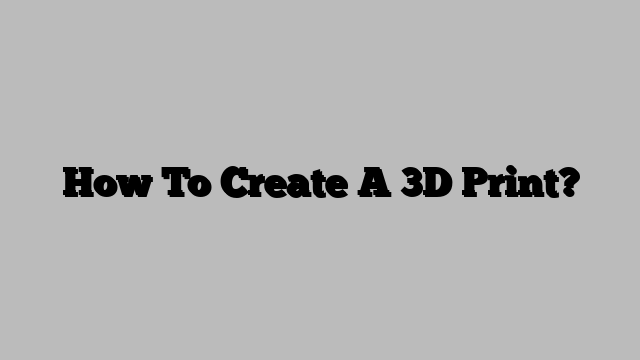How To Create A 3D Print?
3D printing is a fascinating technology that allows you to turn your digital designs into physical objects. Whether you’re interested in creating prototypes, replacement parts, or just fun objects to decorate your home, 3D printing has endless possibilities. In this article, we’ll take you through the steps of creating a 3D print, from design to the final printed object.
Step 1: Design
The first step to creating a 3D print is to design your object in a 3D modeling software. There are many free and paid software options available, including Tinkercad, Fusion 360, and SolidWorks. If you’re new to 3D modeling, Tinkercad is a great place to start as it is easy to use and has many tutorials available. If you have more experience, you may prefer a more advanced software like Fusion 360 or SolidWorks.
When designing your object, you’ll want to consider factors like size, shape, and detail level. Keep in mind that the more intricate the design, the longer it will take to print and the more expensive it may be. Also, pay attention to the orientation of your object as this can affect the quality of the final print.
Step 2: Export
Once your design is complete, you’ll need to export it as an STL file. This file format is widely used in 3D printing and can be read by most 3D printers. Depending on the software you used to create your design, the process for exporting may vary. In most cases, you’ll simply select “Export” from the file menu and choose STL as the file type.
Step 3: Slicing
Now that you have an STL file, you’ll need to prepare it for printing by “slicing” it into layers. This process is done using a software called a slicer, which takes your 3D model and divides it into layers that can be printed one at a time.
There are many slicer software options available, including Cura, Simplify3D, and PrusaSlicer. These software programs allow you to customize settings like layer height, infill density, and print speed. The settings you choose will affect the quality of the final print, as well as the time and cost it takes to print.
Step 4: Printing
Now that your design is sliced and ready to go, it’s time to print! First, make sure your printer is set up and calibrated properly. You’ll also need to load your sliced file into your printer’s software and set the print parameters.
During the printing process, your printer will heat up and extrude filament (usually plastic) layer by layer to create your object. The time it takes to print will depend on factors like the size and complexity of your object, as well as the settings you chose during slicing.
Step 5: Post-Processing
Once your print is finished, you may need to do some post-processing to clean it up and make it look its best. This can include removing any support structures that were printed along with your object, sanding or polishing rough edges, and painting or adding other finishing touches.
Conclusion
Creating a 3D print is an exciting process that allows you to bring your digital designs to life. By following the steps outlined in this article, you’ll be well on your way to creating your own 3D printed objects. Remember to pay attention to the design and slicing settings you choose, as they will have a big impact on the quality and cost of your final print.
